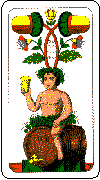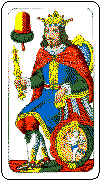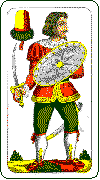Swiss Jass
Part of this page was contributed by Nick Wedd
- Introduction
- The rank and values of the cards
- The trick-taking rules
- The Weis
- The Stöck
- Equipment, clubs, tournaments
- Software
Introduction
Many of the most popular card games in Switzerland, especially in the German speaking cantons, belong to the Jass group, and are played with characteristic Swiss cards, which have come to be known as Jass cards.
So popular has Jass become in Switzerland, that even games which have nothing to do with the Jass group are sometimes described as kinds of Jass, and the word jassen has come to mean playing any card game with the Swiss pack. The Swiss Jass games described on this site at present are:
Rules and advice in German for these and many other Jass games can be found though the sitemap of the Jassonkel web site (archive copy).
Swiss Jass games have a number of features in common, which will be described on this page, to save repetition elsewhere. These are:
The rank and values of the cards
A standard Jass pack has 36 cards. In the west and south of Switzerland French suited cards are used: the four suits are hearts ![]() , diamonds
, diamonds ![]() , spades
, spades ![]() and clubs
and clubs ![]() and and the cards in each suit are ace, king, queen, jack, 10, 9, 8, 7, 6. In the northeast, the cards have the Swiss German suits of bells
and and the cards in each suit are ace, king, queen, jack, 10, 9, 8, 7, 6. In the northeast, the cards have the Swiss German suits of bells ![]() , shields
, shields ![]() , acorns
, acorns ![]() and roses
and roses ![]() . The cards in each suit are ace (or sow), king, ober, under, banner, nine, eight, seven, six. Jass is also played in Liechtenstein with Swiss German cards and in Vorarlberg, the most Western province of Austria, using Single ended German suited cards (the so-called Salzburger pattern) with suits of hearts
. The cards in each suit are ace (or sow), king, ober, under, banner, nine, eight, seven, six. Jass is also played in Liechtenstein with Swiss German cards and in Vorarlberg, the most Western province of Austria, using Single ended German suited cards (the so-called Salzburger pattern) with suits of hearts![]() , bells
, bells ![]() , leaves
, leaves ![]() and acorns
and acorns ![]() each consisting of ace/sow, king ober, unter, 10, 9, 8, 7, 6.
each consisting of ace/sow, king ober, unter, 10, 9, 8, 7, 6.
In some of the more recently developed Jass games there is a hierarchy of suits, but there are several inconsistent ideas of what the correspondence should be between the Swiss German suits, the French suits and the suits used in Vorarlberg. The Jass literature mostly agrees on the following correspondence and ranking of suits from highest to lowest.
| Swiss German | French | Austrian |
|---|---|---|
| bells | hearts | hearts |
| shields | diamonds | bells |
| acorns | spades | leaves |
| roses | clubs | acorns |
However, cards have been printed showing both French and Swiss German suit marks on each card, presumably intended for competitions between players from different parts of Switzerland, with a different suit correspondence: bells=diamonds, shields=spades, acorns=clubs, roses=hearts.
In the Swiss German packs, note that the aces, also known as sows, bear two large suit symbols: originally these cards were in fact deuces. The banners also have two suit symbols, but should be easy to distinguish from aces because their symbols appear on a flag or banner. Perhaps the only tricky card is the ace of shields, which can be confusing because the shields are a different shape from the others. The ace of shields and banner of bells are illustrated below. The king, ober and under of each suit are identified by the words KÖNIG, OBER and UNDER printed on the card.


In the Austrian packs the aces have two suit symbols, the kings are seated and crowned, the obers are standing with the suit symbol at the top, and the unters also stand but with the suit symbol at the bottom of the card.




In North America, Jass cards and equipment can be obtained from TaroBear's Lair.
Jass games are point-trick games. When there are trumps, the card ranks and values are different in the trump suit from the other suits. The rank of the cards in each suit, from highest to lowest, and their values in card points are given in the following table:
| Non trump suit | Trump suit | ||
|---|---|---|---|
| Ace | 11 | Under / Jack | 20 |
| King | 4 | Nine | 14 |
| Ober / Queen | 3 | Ace | 11 |
| Under / Jack | 2 | King | 4 |
| Banner / Ten | 10 | Ober / Queen | 3 |
| Nine | 0 | Banner / Ten | 10 |
| Eight | 0 | Eight | 0 |
| Seven | 0 | Seven | 0 |
| Six | 0 | Six | 0 |
In addition the whoever wins the last trick gets an extra 5 card points. Thus the total number of card points available is 157.
A player or side that wins all the tricks is said to have made match. For this they normally score an extra 100 card points, making 257 altogether.
The Under of trumps is called the Puur (Swiss version of the word Bauer, meaning peasant, which in the form Bower also appears in Euchre). The nine of trumps is called Näll.
Several Jass games have options to play with no trumps, in which case to make up for the lack of Puur and Näll the eights are worth 8 points each instead of zero, so that the total points available are still 157. When no trump options are included, there is usually the choice of playing Obenabe ('von oben hinab' = 'top down' ) in which all suits rank from high to low A-K-Q/O-J/U-10/B-9-8-7-6 or Undenuffe ('von unten hinauf' = 'bottom up') (usually pronounced Un'enu'e) in which the ranking is reversed - from high to low 6-7-8-9-10/B-J/U-Q/O-K-A. Some games have more exotic options such as Slalom (alternate tricks played as Obenabe and Undenuffe).
The trick-taking rules
All Swiss Jass games are played counter-clockwise. The cards are played in tricks. As usual each trick is won by the highest trump in it, or if no trump is played, by the highest card of the suit led. The winner of each trick leads to the next. In many games the player to the right of the dealer leads to the first trick, but in some games with bidding the declarer leads first.
Any card may be led to a trick. The rules about which cards the other players may play to the trick are unique to Swiss Jass. Please read the following carefully! If a non trump suit is led, and you have a card of the suit led, you must either follow suit (play any card of the suit led) or play a trump, subject to the undertrumping rule. If trumps are led, you must follow suit with a trump if you can, except when the only trump in your hand is the Under (Puur), in which case you may play anything. If you have no card of the suit led you may play anything, subject to the undertrumping rule.
Undertrumping rule
There are two versions of this, depending what kind of Jass you are playing.
If it is a pure positive game, such as Schieber Jass, Handjass or Steiger Jass (where the object is to win card points) then the stricter undertrumping rule applies:
- If a non-trump has been led and another player has already trumped it, you are not allowed to play a lower trump, unless you have nothing but trumps left in your hand, in which case you may play any trump.
If it is a negative or mixed game, such as Hindersi, Mittlere or Differenzler in which the object is not to take as many card points as possible, but maybe to avoid taking points or to get close to a specific value, then the weaker undertrumping rule applies:
- If a non-trump has been led and another player has already trumped it, you are not allowed to play a lower trump, unless you have no cards of the suit led, in which case you may play any card.
The Weis
The word Weis denotes sets of cards which, held in a player's hand at the start of play, may be announced for points. There are two ways of counting Weis: the large Weis and the small Weis.
The small Weis are:
| sequence of three cards in suit | 20 points |
| sequence of four cards in suit | 50 points |
| four tens (banners) | 100 points |
| four obers / queens | 100 points |
| four kings | 100 points |
| four aces | 100 points |
| sequence of five or more cards in suit | 100 points |
| four nines (if allowed) | 150 points |
| four unders / jacks | 200 points |
With the small Weis, the same card may not be used in two different combinations. E.g. a player holding all four kings and the ober under ten of bells might choose to treat this as four kings and a sequence of three, or as a sequence of four. A sequence of seven cards scores no more than a sequence of five (though it beats it). A sequence of eight (or nine) cards may be regarded as a sequence of five and a sequence of three (or four).
In the small Weis, a set of four nines is valid only if agreed by the players in advance.
The large Weis are:
| sequence of three cards in suit | 20 points |
| sequence of four cards in suit | 50 points |
| four tens (banners) | 100 points |
| four obers /queens | 100 points |
| four kings | 100 points |
| four aces | 100 points |
| sequence of five cards in suit | 100 points |
| four nines | 150 points |
| sequence of six cards in suit | 150 points |
| four unders / jacks | 200 points |
| sequence of seven in suit | 200 points |
| sequence of eight in suit | 250 points |
| sequence of nine in suit | 300 points |
With the large Weis, the same card may be used in both a set of four and a sequence. E.g. a player holding all four kings and the ober under ten of bells could treat this as four kings and a sequence of four.
Each Weis on a list is better than those above it on the list. A longer sequence is better than a shorter one. In comparing sequences of the same length, the one with the higher card is better. In comparing identical sequences in different suits, one in the trump suit is better. If two players have identical sequences in non-trump suits, the one wins whose turn to play to the first trick is earlier.
For the purposes of Weis, suits are always in the order A, K, O/Q, U/J, B/10, 9, 8, 7, 6. So for example U-B-9 of trumps is a valid sequence of three and U-9-A of trumps is not.
Announcing Weis
The details vary from game to game, but the general way in which Weis are announced is as follows.
As each player plays a card to the first trick of a hand, she may announce one Weis (a scoring set or sequence of cards, as listed) that she holds if it is at least as great as any which has so far been announced. She may hold a Weis but choose not to announce it. She might choose to announce a Weis that was not her best, though it is hard to imagine why anyone should do so deliberately.
When the trick is complete, if Weis has been announced by opposing players, a discussion takes place between them about which one was best. In this discussion players reveal only sufficient information to establish which Weis is highest. For example if there are two four card sequences in contention, the players first each say what is the highest card of their sequence, and if these are equal, whether they are trumps. Once this has been resolved, the holder of the winning Weis scores for it, and for any others which she holds and chooses to announce. In a partnership game, the partner(s) of the player with the best Weis may also announce and score for any Weis they hold. The opponents score nothing for Weis, even though some of theirs may be better than some of the Weis scored by the other side.
Once an item of Weis has been scored for, before the lead to the second trick any player other than the one holding it may ask to see it. Its holder then displays it for everyone to see. The purpose of doing this is not to check if it is genuine (competent card players would know in any case by the end of the hand); it is to help the asker, and possibly her partner, in planning the play of the hand.
Variations
Four 9s, worth 150 points, are allowed as Weis in some Jass variants but not in others. In case of doubt, the players should agree in advance whether they will be allowed.
Some Jass games include the option of Undenuffe in which the cards rank in reverse order - 6 highest. When playing Undenuffe the reverse ranking also applies when comparing sequences of equal length, or equal scoring fours of a kind. For example 6-7-8 is the highest 20-point sequence.
In the late 20th century, in Undenuffe some players began to value the 6 rather than the ace as 11 points and to allow a Weis of four Sixes worth 100 points in place of four Aces. In our view this makes the game less interesting.
Some Swiss Jass rulebooks, notably the recent editions of Puur Näll As by Göpf Egg and Albert Hagenbucher, have promoted a change to the Weis rules, saying that the small Weis is now obsolete, and that the large Weis should be used in all Jass variants where Weis is allowed. They further extend it to allow all fours of a kind to score: four Eights, four Sevens and four Sixes are each worth 100 points. They also support the changed values of 11 for Sixes and zero for Aces in Undenuffe.
Note
Jass games involving announcements of card combinations are played throughout Switzerland. The German word for these announcements is "Weis", but as there is no single correct way to spell Swiss German, various other forms are also found, such as Wis and Wys. It is pronounced "veez". In French the announcements are known as "annonces".
The Stöck
A combination of king and ober of trumps, held by the same player in her hand, generally scores 20 points and is known as Stöck. This is not a kind of Weis and cannot be invalidated by another player's Weis. Stöck can be announced and scored when both the cards have been shown: either when the second of the two cards is been played, or when the cards are exposed as part of a Weis. Alternatively it can be claimed at any later time, up until the counting of points won in tricks at the end of the play of that hand. Stöck can be claimed and scored before the two cards have have appeared in play or as part of an exposed announcement only if the player or team thereby gets enough points to win the game.
Equipment, clubs, tournaments
The site www.jassinfo.ch has an online shop for Jass cards and equipment, plus news and information on clubs and tournaments.
The Schweizer Jassverzeichnis has tournament information and a blog that offers rule clarifications and other material.
Software
Michael Gasser's Jass!! program plays several Swiss Jass games: Differenzler, Sticheln, Plusminus, Guggitaler, Total Guggitaler, Schiltenoberjass, Schaufeldamejass, Molotow, Schellenjass, Handjass, Schieber.